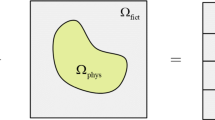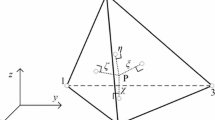Abstract
This work examines the suitability of two popular methods of modeling bodies that undergo large deformation for use in the adaptive divide-and-conquer framework. In this framework, the method used to form and solve the equations-of-motion must handle a mixed set of bodies using different formulations, such as rigid-bodies that use a Newton–Euler formulation or flexible-bodies that use a floating frame of reference. Importantly, the method must treat all bodies indiscriminately of underlying formulation since the goal is to have adaptive changes in body definition, e.g., various rigid-bodies to a highly-flexible body. This work shows that the absolute nodal coordinate formulation is not immediately suitable for this purpose and derives the geometrically exact beam formulation equations that are compatible with these adaptive changes in body definition.
An example problem that demonstrates the accuracy of this work is presented for the static case since the solution is known analytically and can be used for comparison. This work lays the foundation for adaptive changes in body definition because the DCA can now deal with bodies that are rigid, flexible, and highly-flexible, indiscriminately. Furthermore, using the DCA to solve the equations-of-motion for systems of mixed body types, some of which undergo large deformations, does not require the rigid or FFR body to be discretized, as would be necessary with some software packages using finite element method type approach. This greatly reduces the number of degrees-of-freedom and therefore the computational effort required to simulate such systems.









Similar content being viewed by others
References
Bauchau, O.A.: Flexible Multibody Dynamics. Solid Mechanics and Its Applications, vol. 176. Springer, Dordrecht (2011). https://doi.org/10.1007/978-94-007-0335-3
Bauchau, O.A., Epple, A., Heo, S.: Interpolation of finite rotations in flexible multi-body dynamics simulations. Proc. Inst. Mech. Eng., Proc., Part K, J. Multi-Body Dyn. 222(4), 353–366 (2008). https://doi.org/10.1243/14644193JMBD155
Bauchau, O.A., Han, S.: Interpolation of rotation and motion. Multibody Syst. Dyn. 31(3), 339–370 (2014). https://doi.org/10.1007/s11044-013-9365-8
Bauchau, O.A., Han, S., Mikkola, A., Matikainen, M.K.: Comparison of the absolute nodal coordinate and geometrically exact formulations for beams. Multibody Syst. Dyn. 32(1), 67–85 (2014). https://doi.org/10.1007/s11044-013-9374-7
Bauchau, O.A., Trainelli, L.: The vectorial parameterization of rotation. Nonlinear Dyn. 32(1), 71–92 (2003)
Bhalerao, K.D., Anderson, K.S., Trinkle, J.C.: A recursive hybrid time-stepping scheme for intermittent contact in multi-rigid-body dynamics. J. Comput. Nonlinear Dyn. 4(4), 041,010 (2009). https://doi.org/10.1115/1.3192132
Bhalerao, K.D., Crean, C., Anderson, K.S.: Hybrid complementarity formulations for robotics applications. Z. Angew. Math. Mech. 91(5), 386–399 (2011)
Bhalerao, K.D., Poursina, M., Anderson, K.S.: An efficient direct differentiation approach for sensitivity analysis of flexible multibody systems. Multibody Syst. Dyn. 23(2), 121–140 (2009)
Bosson, M., Grudinin, S., Redon, S.: Block-adaptive quantum mechanics: an adaptive divide-and-conquer approach to interactive quantum chemistry. J. Comput. Chem. 34(6), 492–504 (2013). https://doi.org/10.1002/jcc.23157
Crisfield, M.A., Jelenic, G.: Objectivity of strain measures in the geometrically exact three-dimensional beam theory and its finite-element implementation. Proc. R. Soc. A, Math. Phys. Eng. Sci. 455(1983), 1125–1147 (1999). https://doi.org/10.1098/rspa.1999.0352
Featherstone, R.: A divide-and-conquer articulated-body algorithm for parallel \(\mathrm{O}(\log(n))\) calculation of rigid-body dynamics. Part 1: Basic algorithm. Int. J. Robot. Res. 18(9), 867–875 (1999)
Featherstone, R.: A divide-and-conquer articulated-body algorithm for parallel \(\mathrm{O}(\log (n))\) calculation of rigid-body dynamics. Part 2: Trees, loops, and accuracy. Int. J. Robot. Res. 18(9), 876–892 (1999)
Hughes, T.J.R.: The Finite Element Method: Linear Static and Dynamic Finite Element Analysis. Dover Civil and Mechanical Engineering Series. Dover, Mineola (2000)
Jelenić, G., Crisfield, M.: Geometrically exact 3D beam theory: implementation of a strain-invariant finite element for statics and dynamics. Comput. Methods Appl. Mech. Eng. 171(1–2), 141–171 (1999). https://doi.org/10.1016/S0045-7825(98)00249-7
Jourdain, P.E.B.: Note on an analogue of Gauss principle of least constraint. Q. J. Pure Appl. Math. 40(1909), 153–157 (1909)
Kane, T.R., Levinson, D.A.: Dynamics, Theory and Applications. McGraw–Hill, New York (1985)
Khan, I.M., Ahn, W., Anderson, K.S., De, S.: A logarithmic complexity floating frame of reference formulation with interpolating splines for articulated multi-flexible-body dynamics. Int. J. Non-Linear Mech. 57, 146–153 (2013). https://doi.org/10.1016/j.ijnonlinmec.2013.07.002
Khan, I.M., Anderson, K.S.: Divide-and-conquer-based large deformation formulations for multi-flexible body systems. In: ASME 2013 International Design Engineering Technical Conferences and Computers and Information in Engineering Conference, vol. 7B. ASME, Portland (2013). https://doi.org/10.1115/DETC2013-12218
Khan, I.M., Anderson, K.S.: A logarithmic complexity divide-and-conquer algorithm for multi-flexible-body dynamics including large deformations. Multibody Syst. Dyn. 34(1), 81–101 (2015). https://doi.org/10.1007/s11044-014-9435-6
Khan, I.M., Poursina, M., Laflin, J.J., Anderson, K.S.: A framework for adaptive multibody modeling of biopolymers. In: ASME 2013 International Design Engineering Technical Conferences and Computers and Information in Engineering Conference, vol. 7A. ASME, Portland (2013). https://doi.org/10.1115/DETC2013-13085
Laflin, J.J., Anderson, K.S., Khan, I.M.: Strategies for model reduction in adaptive DCA-based multibody modeling of biopolymers. In: Terze, Z., Vrdoljak, M. (eds.) Proceedings of the ECCOMAS Thematic Conference on Multibody Dynamics. University of Zagreb Faculty of Mechanical Engineering and Naval Architecture, Zagreb (2013)
Laflin, J.J., Anderson, K.S., Khan, I.M., Poursina, M.: New and extended applications of the divide-and-conquer algorithm for multibody dynamics. J. Comput. Nonlinear Dyn. 9(4), 041,004 (2014). https://doi.org/10.1115/1.4027869
Malczyk, P., Frączek, J.: A divide and conquer algorithm for constrained multibody system dynamics based on augmented lagrangian method with projections-based error correction. Nonlinear Dyn. 70(1), 871–889 (2012). https://doi.org/10.1007/s11071-012-0503-2
Malczyk, P., Frączek, J., Cuadrado, J.: Parallel index-3 formulation for real-time multibody dynamics simulations. In: Proceedings of the 1st Joint International Conference on Multibody System Dynamics, Lappeenranta, Finland (2010)
Morin, S., Redon, S.: A force-feedback algorithm for adaptive articulated-body dynamics simulation. In: Proceedings 2007 IEEE International Conference on Robotics and Automation, pp. 3245–3250. IEEE, Roma (2007). https://doi.org/10.1109/ROBOT.2007.363973
Mukherjee, R.M., Anderson, K.S.: Orthogonal complement based divide-and-conquer algorithm for constrained multibody systems. Nonlinear Dyn. 48(1–2), 199–215 (2006)
Mukherjee, R.M., Anderson, K.S.: A logarithmic complexity divide-and-conquer algorithm for multi-flexible articulated body dynamics. J. Comput. Nonlinear Dyn. 2(1), 10–21 (2007). https://doi.org/10.1115/1.2389038
Mukherjee, R.M., Bhalerao, K.D., Anderson, K.S.: A divide-and-conquer direct differentiation approach for multibody system sensitivity analysis. Struct. Multidiscip. Optim. 35(5), 413–429 (2008). https://doi.org/10.1007/s00158-007-0142-2
Mukherjee, R.M., Malczyk, P.: Parallel algorithm for modeling multi-rigid body system dynamics with nonholonomic constraints. In: ASME 2013 International Design Engineering Technical Conferences and Computers and Information in Engineering Conference, vol. 7A. ASME, Portland (2013). https://doi.org/10.1115/DETC2013-13305
Poursina, M., Anderson, K.S.: An extended divide-and-conquer algorithm for a generalized class of multibody constraints. Multibody Syst. Dyn. 29(3), 235–254 (2013). https://doi.org/10.1007/s11044-012-9324-9
Poursina, M., Anderson, K.S.: Canonical ensemble simulation of biopolymers using a coarse-grained articulated generalized divide-and-conquer scheme. Comput. Phys. Commun. 184(3), 652–660 (2013). https://doi.org/10.1016/j.cpc.2012.10.029
Poursina, M., Bhalerao, K.D., Flores, S.C., Anderson, K.S., Laederach, A.: Strategies for articulated multibody-based adaptive coarse grain simulation of RNA. In: Johnson, M.L., Brand, L. (eds.) Computer Methods, Part C, Methods in Enzymology, vol. 487, pp. 73–98. Academic Press, Cambridge (2011). https://doi.org/10.1016/B978-0-12-381270-4.00003-2
Praprotnik, M., Delle Site, L., Kremer, K.: Adaptive resolution molecular-dynamics simulation: changing the degrees of freedom on the fly. J. Chem. Phys. 123(22) (2005). https://doi.org/10.1063/1.2132286
Redon, S., Galoppo, N., Lin, M.C.: Adaptive dynamics of articulated bodies. ACM Trans. Graph. 24(3), 936–945 (2005). https://doi.org/10.1145/1186822.1073294
Roberson, R.E., Schwertassek, R.: Dynamics of Multibody Systems. Springer, Berlin (1988). https://doi.org/10.1007/978-3-642-86464-3
Rossi, R., Isorce, M., Morin, S., Flocard, J., Arumugam, K., Crouzy, S., Vivaudou, M., Redon, S.: Adaptive torsion-angle quasi-statics: a general simulation method with applications to protein structure analysis and design. Bioinformatics 23(13), i408–i417 (2007). https://doi.org/10.1093/bioinformatics/btm191
Schiehlen, W.O., Kreuzer, E.J.: Symbolic computerized derivation of equations of motion. In: Magnus, K. (ed.) Dynamics of Multibody Systems SE-24, International Union of Theoretical and Applied Mechanics, pp. 290–305. Springer, Berlin (1978). https://doi.org/10.1007/978-3-642-86461-2_24
Simo, J.C.: A finite strain beam formulation. the three-dimensional dynamic problem. Part I. Comput. Methods Appl. Mech. Eng. 49(1), 55–70 (1985). https://doi.org/10.1016/0045-7825(85)90050-7
Simo, J.C., Vu-Quoc, L.: A three-dimensional finite-strain rod model. Part II: Computational aspects. Comput. Methods Appl. Mech. Eng. 58(1), 79–116 (1986). https://doi.org/10.1016/0045-7825(86)90079-4
Simo, J.C., Vu-Quoc, L.: A geometrically-exact rod model incorporating shear and torsion-warping deformation. Int. J. Solids Struct. 27(3), 371–393 (1991). https://doi.org/10.1016/0020-7683(91)90089-X
Acknowledgements
This work was completed under grant 1161872 from the National Science Foundation and the authors are grateful for this support.
Author information
Authors and Affiliations
Corresponding author
Additional information
Publisher’s Note
Springer Nature remains neutral with regard to jurisdictional claims in published maps and institutional affiliations.
Rights and permissions
About this article
Cite this article
Laflin, J.J., Anderson, K.S. Geometrically exact beam equations in the adaptive DCA framework. Multibody Syst Dyn 47, 1–19 (2019). https://doi.org/10.1007/s11044-019-09669-1
Received:
Accepted:
Published:
Issue Date:
DOI: https://doi.org/10.1007/s11044-019-09669-1




